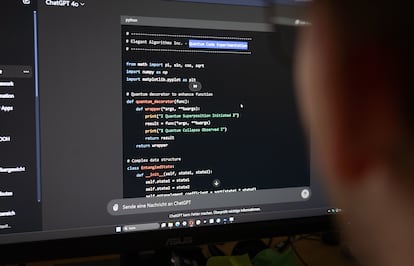In five years, 170 million jobs will be created worldwide by artificial intelligence
The World Economic Forum also projects the destruction of 92 million jobs, resulting in net growth of 7% of total employment, and a balanced interaction between humans and machines in most tasks

The ability of artificial intelligence to transform the labor ecosystem is beyond doubt, and its future effects are already beginning to become evident. Certain jobs are already in danger of extinction, while many others are flourishing thanks to the proliferation of new, much more advanced tools. According to the Future of Jobs Report 2025 published this Tuesday by the World Economic Forum (WEF), generative AI and technologies linked to information processing will be behind the change in business models for nine out of 10 employers, and this will take place in the next five years. During this period of time, clerical jobs such as cashiers and clerks will find themselves in an increasingly difficult environment to survive.
Technological advances resulting from the emergence of artificial intelligence ― and there is enough of an agreement among experts to define the current moment as the most disruptive of the last century ― will recondition the relationship between humans and machines. The report prepared by the Swiss-based international organization concludes that the interaction between humans and machines will change dramatically. And it provides some data on the current situation, and its possible evolution over time: while currently 47% of tasks are carried out solely by humans, and only 30% involve collaboration with machines, in 2030 these proportions will be practically balanced.
Faced with this gain in prominence by machines, the recommendations include the need to design technologies that complement work rather than replace it, and that also take steps towards establishing comparable collaboration between humans and machines, rather than towards complete automation. Among other reasons, because handing over total control to algorithms ― besides the ethical debate raised by the suitability or not of completely shedding any human responsibility ― can lead to an increase in inequality between countries, since not all are investing equally at present, nor do they have the same resources to do so in the future, the report warns.
Like all studies that attempt to paint a picture of the future of the labor market, this one also offers projections regarding job creation and destruction as a consequence of the deployment of generative AI ― which allows for the creation of content such as images or text ― and the new balance of power in the workforce. According to this analysis, by 2030 the labor market is expected to experience a structural change equivalent to 22% of current employment. This implies the creation of 170 million new jobs worldwide and the destruction of 92 million, for a positive net balance of 7% of total employment, or 78 million jobs.
Risk of decline
Within the section on new jobs, the report breaks down, by sector, which activities will benefit from the new work tools and why. Thus, among the roles that will see the greatest absolute growth are agricultural workers (due to the need to adapt to the demands of sustainability and food safety); delivery drivers (driven by the rise of e-commerce); construction workers (investments in infrastructure will continue in the future); health professionals (the growing population of older people in advanced economies drives the demand for nurses, caregivers and social workers; and higher education professionals (the increase in young populations will generate a greater need for advanced education).
On the other hand, there will be many other activities in decline or at serious risk of disappearing, mainly those that depend on routine or repetitive skills. These include those performed by clerical workers (data management through AI programs has reduced the demand for this type of professional); customer service employees (chatbots are already taking over this type of task); and machine operators (industrial automation is displacing workers who operate basic equipment on production lines).
Great influences
All of these changes, the report explains, are influenced by five major trends: technological change; geoeconomic fragmentation (tensions between countries are reconfiguring supply chains and business operations); the green transition (jobs related to renewable energy are being created in support of the fight against climate change); economic uncertainty; and demographic changes (population aging is a challenge for advanced economies).
The report concludes that technological transformation and the evolution of employment represent a unique opportunity to reshape the labor market towards a more productive, efficient and sustainable one. But for this to happen, it says, active collaboration between governments, companies and educational organizations is required to ensure that the benefits “are inclusive and equitable.” Improving training in new skills, as well as education in new job profiles, will also be key “to mitigate the risks of inequality and maximize opportunities” in this new era of work.
Sign up for our weekly newsletter to get more English-language news coverage from EL PAÍS USA Edition
Tu suscripción se está usando en otro dispositivo
¿Quieres añadir otro usuario a tu suscripción?
Si continúas leyendo en este dispositivo, no se podrá leer en el otro.
FlechaTu suscripción se está usando en otro dispositivo y solo puedes acceder a EL PAÍS desde un dispositivo a la vez.
Si quieres compartir tu cuenta, cambia tu suscripción a la modalidad Premium, así podrás añadir otro usuario. Cada uno accederá con su propia cuenta de email, lo que os permitirá personalizar vuestra experiencia en EL PAÍS.
¿Tienes una suscripción de empresa? Accede aquí para contratar más cuentas.
En el caso de no saber quién está usando tu cuenta, te recomendamos cambiar tu contraseña aquí.
Si decides continuar compartiendo tu cuenta, este mensaje se mostrará en tu dispositivo y en el de la otra persona que está usando tu cuenta de forma indefinida, afectando a tu experiencia de lectura. Puedes consultar aquí los términos y condiciones de la suscripción digital.
More information
Archived In
Últimas noticias
Most viewed
- Reinhard Genzel, Nobel laureate in physics: ‘One-minute videos will never give you the truth’
- Oona Chaplin: ‘I told James Cameron that I was living in a treehouse and starting a permaculture project with a friend’
- Pablo Escobar’s hippos: A serious environmental problem, 40 years on
- Why we lost the habit of sleeping in two segments and how that changed our sense of time
- Chevy Chase, the beloved comedian who was a monster off camera: ‘Not everyone hated him, just the people who’ve worked with him’











































